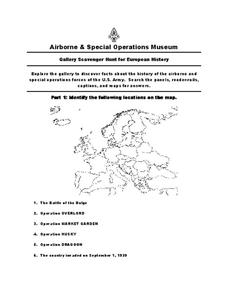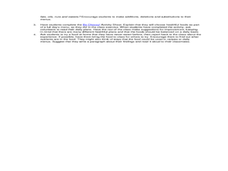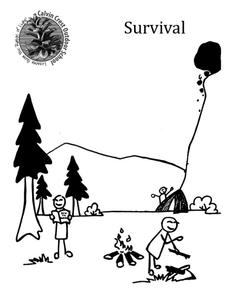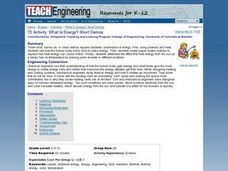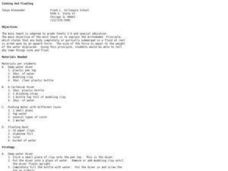Curated OER
The Mighty Hudson Stretches its Mussels
Students brainstorm possible causes of zebra mussel migration and population expansion. They identify the key causes and effects of the disturbance of the Hudson River ecosystem and research causes and effects in the disturbances of...
Curated OER
Winter Holiday Activities Extravaganza
Students define culture and explore elements that are part of the custom or culture of a place. In this holiday lesson, students identify the cultures they participate in. Students identify the differences in people's...
Curated OER
European History
In this world history worksheet , 5th graders look for information related to the history of Europe. They view the facts from a map and apply them to different activities.
Curated OER
Places on the Planet: Latitude and Longitude
Middle schoolers locate different places on globes and maps by learning about latitude and longitude lines. In this latitude and longitude lesson plan, students identify specific locations based on the degrees of latitude and longitude.
Curated OER
Acid Rain
Students investigate the quality of water using a variety of methods. They use a pH probe to measure the pH and study the effect of dissolved CO2 in the water. Students also observe the effect of the pH upon the dissolving of H2SO4 in...
Curated OER
How Do Foods Help Our Bodies
Students investigate the specific elements found in food that keep us healthy. In this healthy eating lesson, students identify proteins, carbohydrates, minerals, and vitamins as part of a healthy diet when consumed in moderation....
Calvin Crest Outdoor School
Survival
Equip young campers with important survival knowledge with a set of engaging lessons. Teammates work together to complete three outdoor activities, which include building a shelter, starting a campfire, and finding directions in the...
Richmond Community Schools
Map Skills
Young geographers will need to use a variety of map skills to complete the tasks required on this worksheet. Examples of activities include using references to label a map of Mexico, identify Canadian territories and European...
Curated OER
Your Five Senses
Students identify the five senses. In this biology lesson, students participate in an experiment and use their five senses to identify various substances.
Curated OER
Maintaining the Internal Environment
Explore homeostasis in animals with this all-encompassing worksheet. Advanced biology pupils consider a variety of mechanisms for maintaining internal conditions such as temperature and waste products. Eighteen short-answer questions...
Curated OER
State or Region Project
Invite your youngsters to learn about a state or region through their choice of a creative project. The resource lists 15 project options that range from a 3-D map of the area, to a puppet show about the region. Pupils can also propose...
Curated OER
Watershed Island
Students make a clay model and a geographic map of a watershed. They talk about the differences between the two representations and the potential human threats to watersheds.
Curated OER
Head to Foot
Students describe the body form and major anatomical structures of squids and describe some unusual or unique features of newly-discovered deep water squid species. They infer what types of food squids use from their anatomical features.
Curated OER
Land Use and Nitrogen
Students consider the effects of development on water quality. They test nitrogen levels in waters before and after development, investigate wastewater treatment options and research best management practices to reduce nitrogen loads.
Curated OER
Animal Skin
Students investigate the skin surface to body area ratios for different animals. In this seventh/eighth grade mathematics/science activity, students explore heat transfer between an animal’s body and the environment. Using...
Curated OER
What Is Energy? Short Demos
Students engage in three short, hands-on, in-class demos which expand students' understand of energy. First, using peanuts and heat, students see how the human body burns food to make energy. Then, they create paper snake mobiles to...
Curated OER
Taste, Smell, Touch
Learners explore the senses, taste, touch and smell. In this lesson about senses, students perform experiments, or activities. Learners complete three activities in order to become more familiar with the three senses of taste, touch, and...
Curated OER
Stella the Swan
Young scholars analyze the telling of a story with props. They study similarities and differences between ducks, geese and swans, how wildfowl are adapted to life in water, how wildfowl move and feed, and wildfowl family life, how they...
Curated OER
Units of Measure
In this identifying units of measure activity, students estimate the volume of their bodies using the bath method and component method, estimate the density of their bodies and use a conversion sheet to convert metric measurements....
Curated OER
Reptiles and Amphibians
Fourth graders explore biology by viewing animal videos in class. In this amphibian and reptile lesson, 4th graders identify the key differences between reptiles, amphibians and other animal classifications. Students view video clips in...
Curated OER
Hunger and Malnutrition
Students recognize that our bodies cannot function without certain essential foods. For this hunger and malnutrition lesson, students become familiar with the problems associated with malnutrition such as medical problems, problems...
Curated OER
What The Peanuts Say: Catabolism and Calories
High schoolers investigate the energy released by a peanut and a piece of a walnut. In this catabolism and calories lesson plan, students burn a peanut and a piece of a walnut and measure the temperature of the water before burning and...
Curated OER
Sinking and Floating
Students examine why some objects float or sink. In this physics lesson, students engage in several mini-experiments which challenge them to draw their own conclusions regarding why certain objects sink or float. An example of one...
Curated OER
The Dose Makes The Poison
Students observe beakers of water that contain different amounts of a mystery chemical. They discuss how each amount of the chemical might affect them if the chemical was beneficial or harmful to their bodies.




